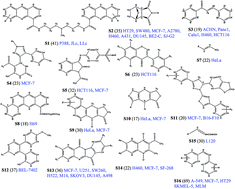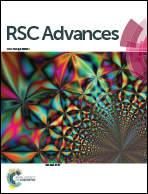Scaffold and cell line based approaches for QSAR studies on anticancer agents†
Abstract
Based on a linear heuristic method, a quantitative structure–activity relationship was developed for the prediction of available in vitro anticancer activity. Each type of compound was represented by several calculated structural descriptors. Most of the computational studies were carried out targeting an insufficient number of cell lines. Predictive models were built for 482 compounds with experimental data against 30 different cancer cell lines. Strong statistical analysis showed a high correlation, cross validation coefficient values and provided a range of QSAR equations. Quantum chemical descriptors were found in 42 out of 46 models, electrostatic in 16, topological in 12, geometrical in 7, thermodynamic in 5 and constitutional in 7. It is interesting to note that in most cases, three descriptor-based models were relevant. Pancreatic cancer cell lines showed the best statistical values (average R2 = 0.87) followed by leukaemia (average R2 = 0.86).



 Please wait while we load your content...
Please wait while we load your content...